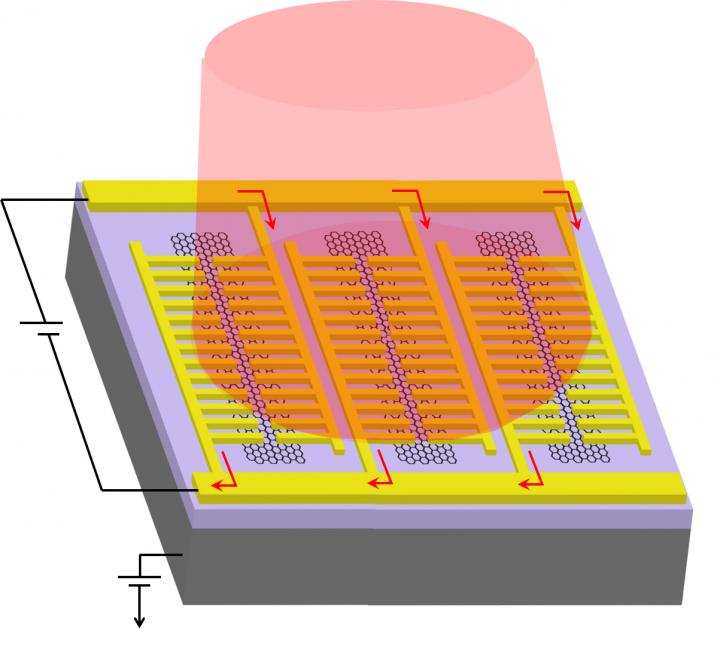
The photodetector operates across a broad range of light, processes images more quickly and is more sensitive to low levels of light than current technology. Credit: UCLA Engineering
Researchers from UCLA are using graphene to develop a new type of photodetector that has superior sensing and imaging capabilities and is able to work with several different types of light.
Graphene, which is a very good conductor of electrical current, is able to detect photons due to its ability to absorb energy form a broad swath of the electromagnetic spectrum—from ultraviolet light to visible light to the infrared and microwave bands.
To create the improved photodetector, the researchers placed strips of graphene over a silicon dioxide layer, which covers a base of silicon. They then created a series of comb-like nanoscale patterns comprised of gold with about 100 nanometer wide teeth.
The graphene is able to catch the incoming photons and convert them into an electrical signal. The gold comb-shaped nanopatterns quickly transfers the information into a processor, which produces a corresponding high-quality image, even under low-light conditions.
“We specifically designed the dimensions of the graphene nanostripes and their metal patches such that incoming visible and infrared light is tightly confined inside them,” Semih Cakmakyapan, a UCLA postdoctoral scholar and the lead author of the study, said in a statement. “This design efficiently produces an electrical signal that follows ultrafast and subtle variations in the light’s intensity over the entire spectral range, from visible to infrared.”
In cameras and other imaging devices, photodetectors sense patterns of photons and create images from the patterns. Different photodetectors sense different parts of the light spectrum. Photodetectors can be used for night vision goggles to sense thermal radiation invisible to the naked eye or in cameras that can identify chemicals in the environment by how they reflect light.
The ability of photodetectors to sense different types of light largely depends on their operating speed, their sensitivity to lower levels of light and how much of the spectrum they can sense. It has proven difficult for engineers to improve a photodetector’s capability in one specific area without diminishing at least one of the other two areas.
However, the new photodetector represents an improvement in all three areas as it operates across a broad range of light, processes images more quickly and is more sensitive to low levels of light than current photodetectors.
“Our photodetector could extend the scope and potential uses of photodetectors in imaging and sensing systems,” Mona Jarrahi, a professor of electrical and computer engineering, who led the study, said in a statement. “It could dramatically improve thermal imaging in night vision or in medical diagnosis applications where subtle differences in temperatures can give doctors a lot of information on their patients. It could also be used in environmental sensing technologies to more accurately identify the concentration of pollutants.”
The study was published in Light: Science & Applications.




